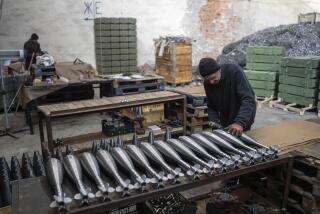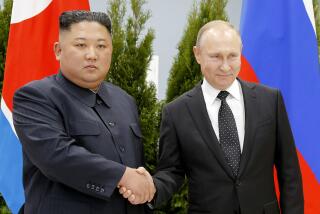Market Focus : Russia Looking East to Sell Arms : Desperate for cash, Moscow is challenging Western nations for the lucrative Asian market.
- Share via
BANGKOK, Thailand — The collapse of the former Soviet Union is almost always viewed with a Western perspective: How it freed Europe from the Iron Curtain, for example, or ended the Cold War with America.
But the upheaval in Moscow is also having a profound impact in Asia, and that in turn may have far-reaching and unexpected consequences for the United States.
The announcement last month that Malaysia intends to buy 18 MIG-29 fighter aircraft from Russia to provide for its air-defense needs into the next century was only the latest sign of a dramatic turnabout in the region.
“Malaysia is an important first step for us,” Russian Foreign Minister Andrei V. Kozyrev noted last week. “We are open to developing a partnership in the military arena with the other countries in the region.”
Malaysia is an integral part of the Assn. of Southeast Asian Nations--a staunchly anti-Communist group that had always been regarded as part of the “Western camp” when it came to buying arms. Its last purchase of fighters, in 1976, was American F-4s.
“Where the Russians didn’t exist in the past, now they’re a factor in every government’s decision,” said Robert Karniol, Asia editor of the London-based Jane’s Defense Weekly. “The key point is, now they are a player.”
After Malaysia’s announcement, the equally anti-Communist military leadership in Thailand said it was considering 30 Russian MI-17V transport helicopters as a successor to a squadron of aging Bell helicopters acquired from the United States in the early 1980s.
But it is economically desperate Russia’s dramatically altered military relationship with China, its former bitter enemy, that has raised the most concerns in the region. Flush with foreign exchange earned through exports, China has embarked on a major military buildup in which Russian military hardware and technology are playing a central role.
“China’s buildup with Russian help will drastically shift the balance of power in the region,” said Bilveer Singh, a lecturer in political science at Singapore’s National University. “With the United States pulling out, China will be the superpower in that part of the world.”
China’s shopping list so far has included 26 advanced Sukhoi 27 fighter-bombers, military transport planes (which can be used for midair refueling), diesel submarines, S300 ground-to-air missiles and 2,000 T-62 tanks. The Chinese are also believed to be negotiating to buy the advanced MIG-31 fighter.
While China’s military modernization has been under way for some time, defense analysts said Beijing still lacks the technology to catch up on its own.
“The Chinese were having trouble advancing their technology, which was far behind advanced countries,” said Jane’s Karniol. “With Russian help, all of a sudden their military technology will be on a par with the most developed nations in the world.”
A publication of the Chinese Public Security Ministry last week confirmed Western reports that China is building an air base in the Paracel Islands in the South China Sea. The islands are astride major sea lanes between the Middle East and Japan. Suddenly China will be projecting its power hundreds of miles from its shores.
One feature of the new Russian sales in Asia is the lack of ideology in the transactions. Whereas in the past the Soviet Union strove to assist “fraternal socialist” countries such as Vietnam or Syria, Russia’s concern appears to be cold cash.
“The Russian military-industrial complex is in a position to earn enough, not only for its own requirements but to feed a considerable proportion of this country as well,” Sergei Akimov, a consultant to the Russian government on foreign economic relations, wrote recently.
Russian salesmen now pay little if any attention to such concerns as limiting weapons proliferation and third-party arms sales. The only condition on the sale of advanced weapons to China, for example, was that they be based in southern China, far away from the Russian border.
It took immense pressure from Washington this month to force Moscow to abandon its plans to sell advanced rocket engines to India--a deal said to be worth $350 million to Moscow. The U.S. government was concerned because India has refused to accept an informal agreement to limit proliferation of missile technology that could be used for military purposes.
Russia’s arms industry is so desperate for cash that it is striking unusual bargains to penetrate the U.S.-dominated market.
With Malaysia, for example, the Russians at first appeared to be losing out to a bid from McDonnell Douglas Corp. for the advanced F/A-18D fighter plane. Then Russian Vice President Alexander V. Rutskoi arrived in Kuala Lumpur in March and agreed to take half the purchase price for the MIGs in commodities such as palm oil.
Thailand said it was considering an offer to pay for half of the proposed $130-million helicopter deal with Russia in rice. The catch phrase for Russian arms became “bargain basement prices.”
Russia also enjoys a price advantage over the United States because it has only partially made the transition to a market economy. Whereas an American company knows precisely how much it costs to manufacture each part of a plane, the Russians haven’t caught up with Western accounting methods and sell equipment based on a hazy estimate of fair value.
Another advantage is the huge stockpile of sophisticated arms the Russians are ready to sell. While the lead time to buy a U.S. warplane can be three years, the Russians promise delivery in six months.
The question of quality has been raised repeatedly in the Malaysian deliberations, but since few countries have experience with both American and Russian hardware at the same time, it can be a tough call. Western defense analysts say the MIG-29 is so sophisticated that the winner of any dogfight with an American or French fighter would be determined more by the quality of the pilot than the plane.
The Russians have made unusual guarantees of quality in order to secure a beachhead in the market. Malaysian Defense Minister Najib Abdul Razak said the Russians will guarantee the life of the warplane’s engine; if it falls short, it will be replaced at no charge. “It’s gratifying to be wooed by so many countries,” Najib said about tiny Malaysia’s newfound leverage.
In addition to Malaysia and Thailand, a number of other countries in the region have entered into preliminary discussions of weapons purchases with Moscow. Some have indicated they will buy small amounts of Russian arms just to keep abreast of the kind of equipment their adversaries might use against them.
That means that in contrast to the past, when most arms sales to Asian countries were from Western manufacturers, the Russians will now be going head to head with Americans virtually everywhere.
For American defense contractors, that means each new contract will be a battle, often resulting in reduced prices, as happened in Malaysia. In addition to the MIGs, the Malaysians agreed to buy eight McDonnell Douglas F/A-18Ds at prices considerably lower than first stipulated, thanks to the rival Russian offer.
Singapore’s Bilveer Singh, viewing the Russian military approach to the region, especially toward China, remarked: “The region’s vulnerability is at a new high point. I’m amazed at the complacency of the United States and Japan.”
Russian Military Sales in Asia
Several deals are pending. Here are profiles of some popular items:
* MIG-29
Type: Single-seat air defense fighter with attack capability.
History: Operational in 1985.
Features: Radar can track 10 targets at once. Can engage targets without emitting detectable radar or radio signals.
Armament: Normally carries six short-range, air-to-air missiles. In attack role, can carry bombs and rockets.
Maximum Speed: 1,520 m.p.h.
Dimensions: Wing span, 37 feet, 3 1/4 inches. Length, 56 feet, 10 inches
Regional Sales: Malaysia plans to buy 18.
* SU-27
Type: Single-seat, air defense fighter and single- or two-seat ground attack aircraft.
History: Entered service in 1984.
Features: Exceptional range on internal fuel tanks and exceptional high angle-of-attack performance.
Maximum Speed: 1,550 m.p.h.
Armament: One 30-millimeter gun and up to 10 air-to-air missiles in air combat role. In ground-attack role, can carry five-round packs of 130-millimeter rockets or larger rocket pods under wings.
Dimensions: Wing span, 48 feet, 2 3/4 inches. Length, 71 feet, 11 1/2 inches
Regional sales: China buying 27.
* MI-17
Type: Twin-turbine, multipurpose helicopter.
History: First displayed at 1981 Paris Air Show.
Features: Can be converted for air-ambulance duties, with room for 12 stretchers.
Maximum Speed: 155 m.p.h
Armament: 23-millimeter gun packs, rockets and missiles.
Dimensions: Main rotor diameter, 69 feet, 10 1/4 inches. Length, 83 feet, 2 inches.
Regional sales: Thailand considering purchase of 30.
* T-62
Type: Battle tank.
History: First seen in Moscow parade in 1965.
Features: Can detect and filter out nuclear fallout, and, in later versions, chemical contaminants.
Maximum Speed: 31 m.p.h.
Armament: 115-millimeter gun.
Dimensions: Length, 22 feet, Width, 11 feet.
Regional sales: China buying 2,000
Sources: Jane’s All the World’s Aircraft 1992-93 and Jane’s Armour and Artillery 1992-93.
More to Read
Sign up for Essential California
The most important California stories and recommendations in your inbox every morning.
You may occasionally receive promotional content from the Los Angeles Times.










